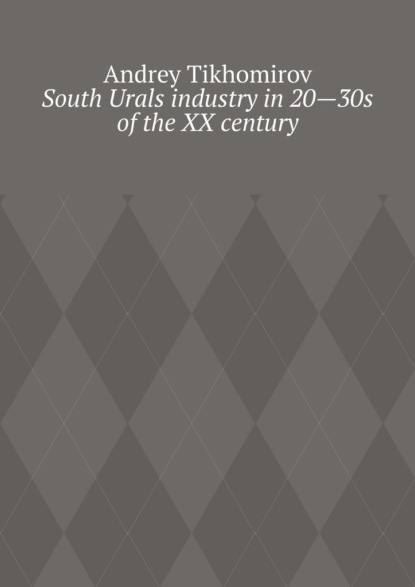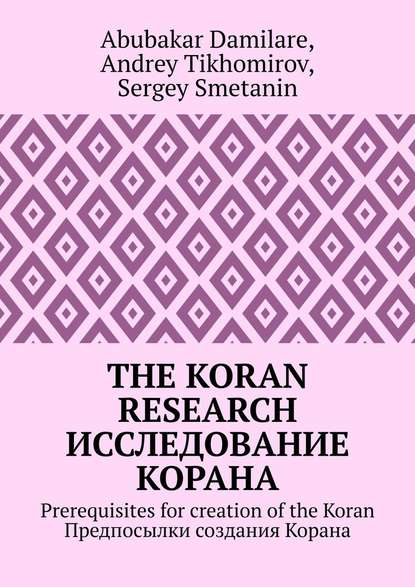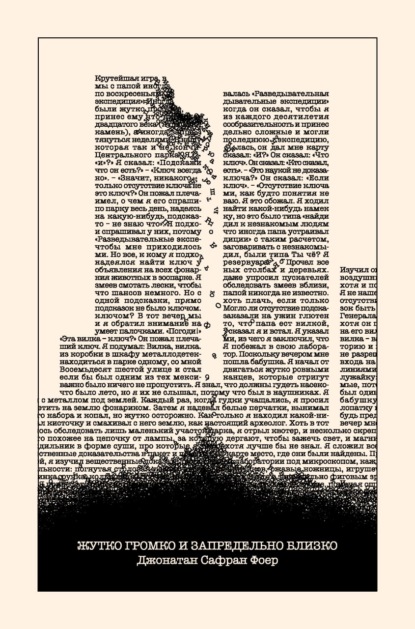
Текст
отзывы: 0 | рейтинг: 0
South Urals industry in 20—30s of the XX century. Scientific research
Andrey Tikhomirov
Industrial development of the South Urals in the years of the new economic policy and pre-war five-year plans is a topic of topical importance for modern Russia. Regardless of political preferences, the problem of the country’s modernization and its accelerated transformation into an industrially developed power comes to the foreground. In this regard, the search for fundamental trends and regularities of historical experience will help to better illuminate ways to solve modern problems.
South Urals industry in 20—30s of the XX century
Scientific research
Andrey Tikhomirov
© Andrey Tikhomirov, 2021
ISBN 978-5-0053-4612-4
Created with Ridero smart publishing system
Register of records of Russia. Record holder. The largest number of thematic books published by a single author:
https://reestrrekordov.ru/naibolshee-kolichestvo-tematicheskih-knig-izdannyh-odnim-avtorom/
Author’s site:
http://gazetavseti.narod.ru/index/0-2
Introduction
Industrial development of the South Urals in the years of the new economic policy and pre-war five-year plans is a topic of topical importance for modern Russia. Regardless of political preferences, the problem of the country’s modernization and its accelerated transformation into an industrially developed power comes to the foreground. In this regard, the search for fundamental trends and regularities of domestic historical experience will help to better illuminate ways to solve modern economic problems.
The construction of the industrial foundation in Russia and the USSR lasted for many decades. The rapid development of industry, which began in Russia after the abolition of serfdom, continued under Soviet rule as an integral, organically interrelated process. In the late 20s – early 30s of the XX century, in connection with the transition to the planned nonproprietary economy, the country’s
leadership relied on theory of “leapfrogging” – an accelerated transition to a developed industrial society.
It was declared about the country’s transformation from agrarian-industrial to industrial-agrarian way of building factories and plants, especially enterprises of heavy industry. Huge funds and allocations were directed to the accelerated development of heavy industry enterprises. Millions of workers and peasants were sent to construction sites. The parallel collectivization – planting of the
kolkhoz system – contributed to the mass influx of workers.
Modernization of the late 20s – early 30s of the XX century in Russia objectively pursued the same goals as the reforms of 60—70s of the XIX century. It also had a “catching-up character”, so it had in many ways the same objectives. The problems of industrialization were set as a priority task for the development of the Soviet economy in the second half of the twenties. At the same time, its main goals were also defined:
the elimination of the country’s industrial underdevelopment;
to achieve economic independence;
to create an industrial base;
priority development of heavy industries.
These tasks were hampered by a lack of material and financial resources, resulting in the centralization of resource allocations. In 1927, Soviet economists began to develop the first five-year plan, which was to provide for the integrated development of the country’s regions and accelerate industrialization.
The transition to industrialization meant a new stage in the development of the entire country. The restoration of the national economy after the end of the civil war took place mainly at the old technical base. The problems of economic recovery were to be solved by a new economic policy introduced in 1921. The socialist industrialization of the country at that time had the main goal of creating the material and technical basis of industry on the basis of state control, development and strengthening of “socialist” production relations in the country, based on state ownership of the means of production. The Soviet power transformed industrialization into a tool for implementing the ideas of restructuring society. The South Urals occupied an important place in the process of industrialization as a raw material base of the country. These are deposits of chrome ore, magnesite, asbestos, copper, iron and nickel ores, salt, oil shale.
The tasks facing the South Urals’ industry were to develop and use new industrial deposits of copper, nickel, iron ores, ceramic raw materials, construction materials, and potash salts. Five years of the 30-s should have promoted accelerated formation of the industry of the region, the inhabitants of the region faced enormous tasks – to turn the agricultural area into an industrial region.
The purpose of scientific work is to illuminate theoretical bases and practical experience of development of the industry of Southern Ural Mountains in years of the new economic policy and pre-war five-years that can be useful for modernity.
Work tasks:
1. to form a holistic view of the South Urals industry development during the new economic policy years;
2. to consider the development of industry in the region during the first five years;
3. to draw main conclusions on the results of industrial development of the region.
Aims, methods, sources, terms of industrialization of the South Urals:
Objectives: to transform the region from an agrarian to an industrial one. industrial-agrarian, ensuring technical-economic independence, to strengthen the defense capabilities and improve the welfare of the people, a demonstration of the benefits of socialism;
Methods: State initiative supported by enthusiasm from below.
Command and administrative methods dominate – the systematic nature of industrialization;
Sources: domestic savings, loans, pumping out of the village, foreign trade income, cheap labour, worker enthusiasm, prison labour; the tight deadlines for industrialization and the concomitant pace of its implementation. High growth of industrial production.
Negative moments of industrialization which have appeared in Southern Ural: commodity hunger, ration cards (1928—1935), decrease in wages, shortage of highly skilled personnel, migration of the population and aggravation of housing problems, difficulties in adjustment of new manufacture, mass accidents and breakdowns – search for guilty, reprisals.
The basic directions of economic activity in Southern Urals: the accelerated rates of development of the enterprises of group “A” (manufacture of means of manufacture), the main problem – creation of the second coal-metallurgical base in the east (the Ural-Kuznetsk industrial complex), creation of new industries, struggle for mastering of new technics, development of power base, preparation
of qualified labour force and ITR.
The end of the civil war created the necessary conditions for the immediate start of “socialist” construction, but to begin construction in early 1921 was even harder than in early 1918. During the Civil War, Russia’s already backward economy was thrown back decades. Only the small peasant farms that prevailed in the country at the time could provide food for the starving population of the cities and raw materials for the destroyed industry. Therefore, under the new economic policy, the Soviet authorities had to use private capital to produce the necessary industrial goods more quickly. The transition to new economic policy thus, from the point of view of Soviet historians, meant a temporary resumption of capitalist production in small industrial and artisanal enterprises producing consumer goods. As a result, a number of small enterprises were denationalized, and private individuals were allowed to rent public enterprises. Capitalists were only allowed to produce a number of consumer goods, i.e. in very necessary, but not decisive, sectors of production. And the decisive industries, according to Soviet economists, the command heights in the economy – large industry, land, banks, transport, foreign trade – were to remain in the hands of the Soviet state.
“Russia later countries of Western Europe embarked on the path of industrial development in the late XIX and early XX centuries. By the time of the October socialist revolution, it remained an agrarian country with a predominance of precapitalist small commodity production of peasants and craftsmen (about 90% of the total working population). This meant that there were no material conditions for direct and direct transition to socialism. Aware of and considering this fact, in 1921 Lenin proposed a new economic policy, namely: to direct the inevitable development of small commodity and capitalist production in the direction of state capitalism of a special kind, with a public sector leading role in industry and under the control of the state of workers and in their interests through intermediary links (cooperation of small producers, equivalent to the exchange of goods between town and village, the use of the market and commodity-money relations). This was the only possible and scientifically sound way of moving towards socialism.
But the intensification of class struggle within the country and the growing threat of new intervention by the capitalist environment in the late 1920s raised the question of accelerating the transition to socialism and boosting industrialization (creation of heavy industry as the basis of the country’s defense capability). In 1931 it was decided to accelerate the transition to socialism and to force industrialization (creation of a heavy industry as the basis of the country’s defense capacity). Stalin harshly formulated the choice: “We are -150 years behind the capitalist West. We have to go this way in 10 years. Either we will do it, for we are in doubt”. This conclusion turned out to be prophetic and was confirmed in 1941”.
The problems of industrial production development were actively covered. Theoretical discussions in the mid-20s centred on the questions of how to carry out industrialization (should we start with light industry, i.e. should we go for “chintz industrialization”), where to get sources for huge investments in heavy industry?
Economists of Marxist-Leninist direction saw in socialist industrialization practical realization of requirements of the law of preferential growth of production means of production. Such ideas were substantiated by S.Strumilin. He analyzed the rate of capital accumulation in the industry of pre-revolutionary Russia and compared it with the Soviet time. From such analysis, he concluded that the country had all the prerequisites for accelerated industrialization and for exceeding the previously known growth rates.
F.E. Dzerzhinsky, S. Ordzhonikidze, V.I. Mezhlauk, V.V. Mezhlauk actively defended the Bolshevik concept of socialist industrialization. Kuibyshev, A.I. Rykov.
They were opposed by economists, who at that time were known as “bourgeois” (B. Brutskus, L. Litoshenko, L. Yurovsky, etc.). B. Brutskus, L. Litoshenko insisted on the inadmissibility of redistribution of national income in favor of industry. L. Yurovsky proposed to achieve a balanced market by restraining capital construction. (Bukharin N.I., Preobrazhensky E.A. Ways of Development: Discussions of the 20s. – L.: Lenizdat, 1990. Lenin V.I. Draft resolution on the report on electrification // Op. cit. – _. 42. – _. 196, Trotsky’s
Archive. – M.: Terra Publishing Centre, 1990. – T. 3,4.
Stromilin S.G. Statistics and Economics. – Moscow: Science, 1979. – _. 28. His own. Problems of Economics of Labour. – Moscow: Science, 1982.
Dzerzhinsky F.E. Selected works. – T. 2. – M.: Politizdat, 1977, S. Ordzhonikidze. Articles and speeches. – T. 2. – 1926—1937: Politizdat, 1977,
Ordzhonikidze S. Articles and Speeches – T. – M.: Gospolitizdat, 1957, Mezhlauk V.I. Cheapening of construction – decisive link in the construction program of 1936.-M.: PartizdatskKVKShchb), 1935, Kuibyshev V.V. Selected works.-M.: Gospolitizdat, 1958, A.I. Rykov Selected works.-M.: Economics, 1990).
We do not tend to stick the label of “bourgeoisness” to economists L. Yurovsky and L. Litoshenko. Their proposed concept of painless and gradual progressive development of the country now looks much more attractive than the one according to which it was developed. However, our theoretical calculations allow us to conclude that this best concept of development did not sufficiently take into account the time factor. History has devoted too little time to industrialization.
Nikolai Dmitrievich Kondratyev – the biggest economist and theorist of that time – took his own position. Without opposing the course of industrialization, Kondratyev, in fact, was against the disproportionate development of major industries, as he saw it as a basis for possible future economic crises. He objected to the high growth rates and savings rates adopted, believing them to be unjustified.
N.I. Bukharin proposed to develop our industry on the basis of increasing the technical level, however, in strict compliance with both the market capacity and the financial capacity of the state. He advocated rapid but balanced growth of the heavy industry with other industries.
With many comparative shortcomings in the struggle of ideas won the plan of transformation, which was proposed by most of the country’s leadership, headed by Stalin. This plan took into account the factor of limited time.
The main mistake of Stalin’s critics is an attempt to prove their ignorance of the economic laws of development. That was a clear distortion of the truth. On the contrary, he stressed: “At our enterprises are relevant issues such as the question of economic calculation and profitability, the question of cost, the question of prices, etc. Therefore, our enterprises cannot and should not do without the law of cost”. (Yurovsky L. Modern problems of monetary policy. – _., 1926. – _. 54,
Kondratyev N.D. Problems of economic dynamics. – Moscow: Economics, 1989, Kun M. Bukharin: his friends and enemies. – Moscow: Republic, 1992, Stalin I.V. Economic Problems of Socialism in the USSR. – Moscow: Gosolitizdat, 1952. – 20).
South Ural industry in the new economic policy years
In the beginning of 20th years of XX century the first concrete step in revival of economy of Southern Ural Mountains has been made. In March 1921 the X Congress of the RCP (b) took place, which took a course on a new economic policy, and by the decree from May 17 on abolition of nationalization of small enterprises each citizen was given the right to be engaged in trade, to organize small industrial enterprises with the number of workers not more than 10—15 people. The revival and development of the market and the monetary system were declared to be the main principles of the New economic policy, while in the industrial sector the transition to commercial settlement, overcoming the wage equalization, the development of cooperative and other non-state enterprises.
The first and main measure of the new economic policy was to replace food politics with a food tax, initially set at about 20% of the net product of peasant labor (i.e., requiring almost twice as much bread as food politics), and then reducing to 10% of the crop and less and took the form of money. The peasant could sell the remaining products after the prolongation of the tax at his discretion – either to the state or on the free market.
Radical transformations have taken place in industry. Senior managements were abolished, and instead trusts were created – associations of homogeneous or interrelated enterprises, which gained full economic and financial independence, up to the right to issue long-term bonded loans.
Andrey Tikhomirov
Industrial development of the South Urals in the years of the new economic policy and pre-war five-year plans is a topic of topical importance for modern Russia. Regardless of political preferences, the problem of the country’s modernization and its accelerated transformation into an industrially developed power comes to the foreground. In this regard, the search for fundamental trends and regularities of historical experience will help to better illuminate ways to solve modern problems.
South Urals industry in 20—30s of the XX century
Scientific research
Andrey Tikhomirov
© Andrey Tikhomirov, 2021
ISBN 978-5-0053-4612-4
Created with Ridero smart publishing system
Register of records of Russia. Record holder. The largest number of thematic books published by a single author:
https://reestrrekordov.ru/naibolshee-kolichestvo-tematicheskih-knig-izdannyh-odnim-avtorom/
Author’s site:
http://gazetavseti.narod.ru/index/0-2
Introduction
Industrial development of the South Urals in the years of the new economic policy and pre-war five-year plans is a topic of topical importance for modern Russia. Regardless of political preferences, the problem of the country’s modernization and its accelerated transformation into an industrially developed power comes to the foreground. In this regard, the search for fundamental trends and regularities of domestic historical experience will help to better illuminate ways to solve modern economic problems.
The construction of the industrial foundation in Russia and the USSR lasted for many decades. The rapid development of industry, which began in Russia after the abolition of serfdom, continued under Soviet rule as an integral, organically interrelated process. In the late 20s – early 30s of the XX century, in connection with the transition to the planned nonproprietary economy, the country’s
leadership relied on theory of “leapfrogging” – an accelerated transition to a developed industrial society.
It was declared about the country’s transformation from agrarian-industrial to industrial-agrarian way of building factories and plants, especially enterprises of heavy industry. Huge funds and allocations were directed to the accelerated development of heavy industry enterprises. Millions of workers and peasants were sent to construction sites. The parallel collectivization – planting of the
kolkhoz system – contributed to the mass influx of workers.
Modernization of the late 20s – early 30s of the XX century in Russia objectively pursued the same goals as the reforms of 60—70s of the XIX century. It also had a “catching-up character”, so it had in many ways the same objectives. The problems of industrialization were set as a priority task for the development of the Soviet economy in the second half of the twenties. At the same time, its main goals were also defined:
the elimination of the country’s industrial underdevelopment;
to achieve economic independence;
to create an industrial base;
priority development of heavy industries.
These tasks were hampered by a lack of material and financial resources, resulting in the centralization of resource allocations. In 1927, Soviet economists began to develop the first five-year plan, which was to provide for the integrated development of the country’s regions and accelerate industrialization.
The transition to industrialization meant a new stage in the development of the entire country. The restoration of the national economy after the end of the civil war took place mainly at the old technical base. The problems of economic recovery were to be solved by a new economic policy introduced in 1921. The socialist industrialization of the country at that time had the main goal of creating the material and technical basis of industry on the basis of state control, development and strengthening of “socialist” production relations in the country, based on state ownership of the means of production. The Soviet power transformed industrialization into a tool for implementing the ideas of restructuring society. The South Urals occupied an important place in the process of industrialization as a raw material base of the country. These are deposits of chrome ore, magnesite, asbestos, copper, iron and nickel ores, salt, oil shale.
The tasks facing the South Urals’ industry were to develop and use new industrial deposits of copper, nickel, iron ores, ceramic raw materials, construction materials, and potash salts. Five years of the 30-s should have promoted accelerated formation of the industry of the region, the inhabitants of the region faced enormous tasks – to turn the agricultural area into an industrial region.
The purpose of scientific work is to illuminate theoretical bases and practical experience of development of the industry of Southern Ural Mountains in years of the new economic policy and pre-war five-years that can be useful for modernity.
Work tasks:
1. to form a holistic view of the South Urals industry development during the new economic policy years;
2. to consider the development of industry in the region during the first five years;
3. to draw main conclusions on the results of industrial development of the region.
Aims, methods, sources, terms of industrialization of the South Urals:
Objectives: to transform the region from an agrarian to an industrial one. industrial-agrarian, ensuring technical-economic independence, to strengthen the defense capabilities and improve the welfare of the people, a demonstration of the benefits of socialism;
Methods: State initiative supported by enthusiasm from below.
Command and administrative methods dominate – the systematic nature of industrialization;
Sources: domestic savings, loans, pumping out of the village, foreign trade income, cheap labour, worker enthusiasm, prison labour; the tight deadlines for industrialization and the concomitant pace of its implementation. High growth of industrial production.
Negative moments of industrialization which have appeared in Southern Ural: commodity hunger, ration cards (1928—1935), decrease in wages, shortage of highly skilled personnel, migration of the population and aggravation of housing problems, difficulties in adjustment of new manufacture, mass accidents and breakdowns – search for guilty, reprisals.
The basic directions of economic activity in Southern Urals: the accelerated rates of development of the enterprises of group “A” (manufacture of means of manufacture), the main problem – creation of the second coal-metallurgical base in the east (the Ural-Kuznetsk industrial complex), creation of new industries, struggle for mastering of new technics, development of power base, preparation
of qualified labour force and ITR.
The end of the civil war created the necessary conditions for the immediate start of “socialist” construction, but to begin construction in early 1921 was even harder than in early 1918. During the Civil War, Russia’s already backward economy was thrown back decades. Only the small peasant farms that prevailed in the country at the time could provide food for the starving population of the cities and raw materials for the destroyed industry. Therefore, under the new economic policy, the Soviet authorities had to use private capital to produce the necessary industrial goods more quickly. The transition to new economic policy thus, from the point of view of Soviet historians, meant a temporary resumption of capitalist production in small industrial and artisanal enterprises producing consumer goods. As a result, a number of small enterprises were denationalized, and private individuals were allowed to rent public enterprises. Capitalists were only allowed to produce a number of consumer goods, i.e. in very necessary, but not decisive, sectors of production. And the decisive industries, according to Soviet economists, the command heights in the economy – large industry, land, banks, transport, foreign trade – were to remain in the hands of the Soviet state.
“Russia later countries of Western Europe embarked on the path of industrial development in the late XIX and early XX centuries. By the time of the October socialist revolution, it remained an agrarian country with a predominance of precapitalist small commodity production of peasants and craftsmen (about 90% of the total working population). This meant that there were no material conditions for direct and direct transition to socialism. Aware of and considering this fact, in 1921 Lenin proposed a new economic policy, namely: to direct the inevitable development of small commodity and capitalist production in the direction of state capitalism of a special kind, with a public sector leading role in industry and under the control of the state of workers and in their interests through intermediary links (cooperation of small producers, equivalent to the exchange of goods between town and village, the use of the market and commodity-money relations). This was the only possible and scientifically sound way of moving towards socialism.
But the intensification of class struggle within the country and the growing threat of new intervention by the capitalist environment in the late 1920s raised the question of accelerating the transition to socialism and boosting industrialization (creation of heavy industry as the basis of the country’s defense capability). In 1931 it was decided to accelerate the transition to socialism and to force industrialization (creation of a heavy industry as the basis of the country’s defense capacity). Stalin harshly formulated the choice: “We are -150 years behind the capitalist West. We have to go this way in 10 years. Either we will do it, for we are in doubt”. This conclusion turned out to be prophetic and was confirmed in 1941”.
The problems of industrial production development were actively covered. Theoretical discussions in the mid-20s centred on the questions of how to carry out industrialization (should we start with light industry, i.e. should we go for “chintz industrialization”), where to get sources for huge investments in heavy industry?
Economists of Marxist-Leninist direction saw in socialist industrialization practical realization of requirements of the law of preferential growth of production means of production. Such ideas were substantiated by S.Strumilin. He analyzed the rate of capital accumulation in the industry of pre-revolutionary Russia and compared it with the Soviet time. From such analysis, he concluded that the country had all the prerequisites for accelerated industrialization and for exceeding the previously known growth rates.
F.E. Dzerzhinsky, S. Ordzhonikidze, V.I. Mezhlauk, V.V. Mezhlauk actively defended the Bolshevik concept of socialist industrialization. Kuibyshev, A.I. Rykov.
They were opposed by economists, who at that time were known as “bourgeois” (B. Brutskus, L. Litoshenko, L. Yurovsky, etc.). B. Brutskus, L. Litoshenko insisted on the inadmissibility of redistribution of national income in favor of industry. L. Yurovsky proposed to achieve a balanced market by restraining capital construction. (Bukharin N.I., Preobrazhensky E.A. Ways of Development: Discussions of the 20s. – L.: Lenizdat, 1990. Lenin V.I. Draft resolution on the report on electrification // Op. cit. – _. 42. – _. 196, Trotsky’s
Archive. – M.: Terra Publishing Centre, 1990. – T. 3,4.
Stromilin S.G. Statistics and Economics. – Moscow: Science, 1979. – _. 28. His own. Problems of Economics of Labour. – Moscow: Science, 1982.
Dzerzhinsky F.E. Selected works. – T. 2. – M.: Politizdat, 1977, S. Ordzhonikidze. Articles and speeches. – T. 2. – 1926—1937: Politizdat, 1977,
Ordzhonikidze S. Articles and Speeches – T. – M.: Gospolitizdat, 1957, Mezhlauk V.I. Cheapening of construction – decisive link in the construction program of 1936.-M.: PartizdatskKVKShchb), 1935, Kuibyshev V.V. Selected works.-M.: Gospolitizdat, 1958, A.I. Rykov Selected works.-M.: Economics, 1990).
We do not tend to stick the label of “bourgeoisness” to economists L. Yurovsky and L. Litoshenko. Their proposed concept of painless and gradual progressive development of the country now looks much more attractive than the one according to which it was developed. However, our theoretical calculations allow us to conclude that this best concept of development did not sufficiently take into account the time factor. History has devoted too little time to industrialization.
Nikolai Dmitrievich Kondratyev – the biggest economist and theorist of that time – took his own position. Without opposing the course of industrialization, Kondratyev, in fact, was against the disproportionate development of major industries, as he saw it as a basis for possible future economic crises. He objected to the high growth rates and savings rates adopted, believing them to be unjustified.
N.I. Bukharin proposed to develop our industry on the basis of increasing the technical level, however, in strict compliance with both the market capacity and the financial capacity of the state. He advocated rapid but balanced growth of the heavy industry with other industries.
With many comparative shortcomings in the struggle of ideas won the plan of transformation, which was proposed by most of the country’s leadership, headed by Stalin. This plan took into account the factor of limited time.
The main mistake of Stalin’s critics is an attempt to prove their ignorance of the economic laws of development. That was a clear distortion of the truth. On the contrary, he stressed: “At our enterprises are relevant issues such as the question of economic calculation and profitability, the question of cost, the question of prices, etc. Therefore, our enterprises cannot and should not do without the law of cost”. (Yurovsky L. Modern problems of monetary policy. – _., 1926. – _. 54,
Kondratyev N.D. Problems of economic dynamics. – Moscow: Economics, 1989, Kun M. Bukharin: his friends and enemies. – Moscow: Republic, 1992, Stalin I.V. Economic Problems of Socialism in the USSR. – Moscow: Gosolitizdat, 1952. – 20).
South Ural industry in the new economic policy years
In the beginning of 20th years of XX century the first concrete step in revival of economy of Southern Ural Mountains has been made. In March 1921 the X Congress of the RCP (b) took place, which took a course on a new economic policy, and by the decree from May 17 on abolition of nationalization of small enterprises each citizen was given the right to be engaged in trade, to organize small industrial enterprises with the number of workers not more than 10—15 people. The revival and development of the market and the monetary system were declared to be the main principles of the New economic policy, while in the industrial sector the transition to commercial settlement, overcoming the wage equalization, the development of cooperative and other non-state enterprises.
The first and main measure of the new economic policy was to replace food politics with a food tax, initially set at about 20% of the net product of peasant labor (i.e., requiring almost twice as much bread as food politics), and then reducing to 10% of the crop and less and took the form of money. The peasant could sell the remaining products after the prolongation of the tax at his discretion – either to the state or on the free market.
Radical transformations have taken place in industry. Senior managements were abolished, and instead trusts were created – associations of homogeneous or interrelated enterprises, which gained full economic and financial independence, up to the right to issue long-term bonded loans.
Другие книги автора:
Популярные книги
























